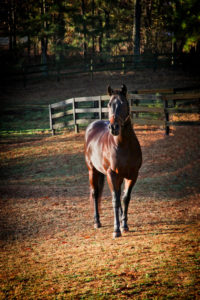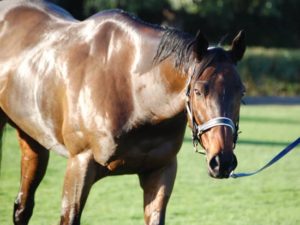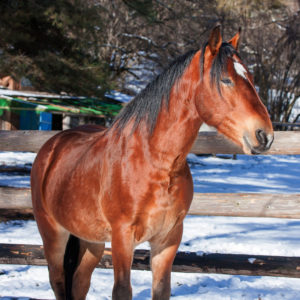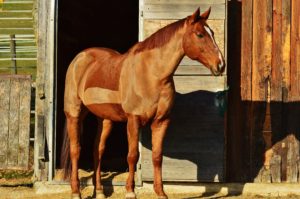 For many, winter means darker days, more blankets, mud and much longer coats. It therefore may seem counterproductive thinking about your horse’s coat condition prior to spring. However, now is the best time, as good practices started early will allow for adaptations to take place for sparkling spring coats.
For many, winter means darker days, more blankets, mud and much longer coats. It therefore may seem counterproductive thinking about your horse’s coat condition prior to spring. However, now is the best time, as good practices started early will allow for adaptations to take place for sparkling spring coats.
If you are concerned with your horse’s coat condition it may be worth a quick check with your veterinarian to rule out conditions that could affect the coat, such as gastric ulcers, internal parasites, and even Cushing’s disease.
While nutrition plays a part in horses having good quality coats there is more to it than that. As with all coat colors, dapples and coat condition in part, are controlled by genetics. Some breeds just simply develop a much thicker, longer, “scruffier” coat than others. Dapples themselves result from variation in the patterns of red vs. black pigment along the hair shaft, rather than changes in pigmentation across the skin. Therefore, they do disappear when you clip a dappled horse. Do keep in mind that some horses are just more likely to shine than others.
Even horses in good condition could be missing the essentials needed to support a shiny coat. Nutrients, such as omega fatty acids; trace minerals such as zinc and copper; essential amino acids and vitamins such as A, E, B must be present in the correct amounts to get a great coat.
Vitamins and Minerals
The best place to start is with your forage. Feed the best-quality forage you can, and make sure your horse is getting enough.
Vitamin A is a vital nutrient in the role of skin health, and while equine deficiencies are rare, they can occur if older hay is fed. Beta-Carotene is the precursor to vitamin A and is abundant in fresh forages. However, it is lost at a rate of 10% per month from hay. Therefore, by late winter/early spring hay may have lost 50% of its beta-carotene, and by the time hay is a year old it’s likely horses will need additional support to meet basic daily requirements.
Fresh good-quality grass pasture is also an excellent source of vitamin E. Diets lacking in Vit E can be a causative factor in dry skin, skin infections and allergic reactions.
A horse that is sustaining itself on good-quality grass pasture will be consuming significant amounts, however, because vitamin E is not heat-stable its levels in hay can decrease over time. Another consideration is that in winter months when fresh grass isn’t as plentiful the amount consumed per day will be less than in summer.
Both, Vit B7 (Biotin)which is necessary for skin health, and B6 which is a valuable component of protein metabolism, should also be noted for coat condition. A deficiency can be seen sometimes in older horses which results in thinning of the coat, bald patches and extremely dry skin and scaling.
Zinc and copper are two trace minerals that are worth paying attention to. Both are needed for melanin production, and so have an impact on coat color. If the hair contains inadequate amounts of melanin, it is unable to resist damage from ultraviolet light which can lead to damage and fading. Copper is also needed by the enzyme lysyl oxidase, which is necessary for the maintenance of the cross-bridges in collagen within skin. Without adequate copper these cross linkages are weakened, and the skin loses structural integrity.
Fatty Acids
 Fats supply essential fatty acids (EFAs) which are a component of skin oils (sebum) that coat both the skin and hair shaft. The hair shaft is covered in cells that help to retain moisture. When there is a good coating of sebum these cells lay flat, giving off a good reflection which we perceive as shine. However, if damaged, moisture is lost from the hair shaft, and the hair becomes dry and these cells in a sense “stick up” and no longer reflect light with the same luster. Diets that don’t provide adequate amounts of EFAs could result in a dry coat that’s more prone to damage and a dull appearance.
Fats supply essential fatty acids (EFAs) which are a component of skin oils (sebum) that coat both the skin and hair shaft. The hair shaft is covered in cells that help to retain moisture. When there is a good coating of sebum these cells lay flat, giving off a good reflection which we perceive as shine. However, if damaged, moisture is lost from the hair shaft, and the hair becomes dry and these cells in a sense “stick up” and no longer reflect light with the same luster. Diets that don’t provide adequate amounts of EFAs could result in a dry coat that’s more prone to damage and a dull appearance.
Do take caution before adding fat as it may not be appropriate for all horses based on body condition. However, even fairly small amounts of fat should have a positive impact on coat quality without contributing too many calories.
Try to use fat sources that supply larger amounts of Omega-3 than Omega-6, as Omega 3 has anti-inflammatory properties which have been shown to have positive effects on skin quality and aid in the reduction of itching. Fish oils and flax are good Omega 3 options.
For coat condition 2 to 4 ounces per day for an average-sized horse would be ideal.
Dietary fats are also beneficial as they facilitate the absorption of fat-soluble vitamins A, D, E, and K.
Protein
 Hair is 90% protein and the hair shafts are made up of the protein keratin. Diets that provide inadequate amounts of protein or that lack essential amino acids (EAA) could result in poor hair growth. In modern diets generally its not a lack of protein that is an issue but a lack of EAA’s such as lysine. A simple way to improve the EAA level is to include a variety of hays including alfalfa and/or use an appropriate concentrate or ration balancer to ensure levels are met.
Hair is 90% protein and the hair shafts are made up of the protein keratin. Diets that provide inadequate amounts of protein or that lack essential amino acids (EAA) could result in poor hair growth. In modern diets generally its not a lack of protein that is an issue but a lack of EAA’s such as lysine. A simple way to improve the EAA level is to include a variety of hays including alfalfa and/or use an appropriate concentrate or ration balancer to ensure levels are met.
Besides diet, good grooming practices are vitally important for coat quality.
Professional groom Liv Gude, founder of Pro Equine Grooms, notes that “It boils down to environment, care, health, and diet. Your horse’s coat shows a little bit of what’s going on inside him, as well as just how dirty he likes to be on the outside. Daily currying and brushing is more than removing dirt, it’s skin care. Sebum, the natural oil produced by the skin, is antimicrobial, water-proof, and shiny. Your grooming skills are needed to maximize the benefits of healthy skin.”
To improve a horses coat “Get on board with spending a ton of time on curry combing. Grooming gloves are great for this, you can use two hands at once and really get down to it” suggests Gude, once done dirt can be removed with a stiff brush.
As we head towards winter the question many ask is, “Should I clip my horse or not”?
“There are plenty of reasons why you would need, or not need, to clip your horse”, says Gude. “Part of this is a personal preference. But, the largest and most important reason is to shorten your horse's coat for health and comfort”
“While it's commonly thought that climate and temperature dictate how much hair a horse will grow, it's actually the amount of daylight.” “The climate around you may not match what your horse grows! Clipping is a thoughtful way to help him stay comfortable” 
Liv Gude also notes that “when an exercise or training routine over winter creates a lot of sweat your horse may need help thermoregulating efficiently”
“One study discovered that clipped horses maintained their vitals well, while unclipped horses had longer exercise recovery rates. Another found that clipped horses showed less strain on the body's activity to thermoregulate and exercise more efficiently. A sweaty horse in winter also has to deal with a longer drying time”
“If there's a history of skin infections, like equine pastern dermatitis (EPD), rain rot, matted hair, sores, or other weird skin funk, you may want to consider clipping. Long hair on some horses is the perfect storm for a skin issue. Hair traps moisture, dirt, sweat, dander, mud, and sometimes even lice and mites. You can see the skin, clean the skin, and medicate it much more comfortably without a forest of hair. It's just that simple”
If you decide that clipping is for you this winter, check out Liv’s extensive guide to clipping. Whether you decide to clip or not, feeding the necessary precursors for a healthy coat through the winter months will give you the best chance of a beautiful shiny horse come spring.
Not sure if your horse is getting all these key coat nutrients in the correct amounts? We would love to help.
For everything you need to know about clipping your horse check out Liv's guide here.